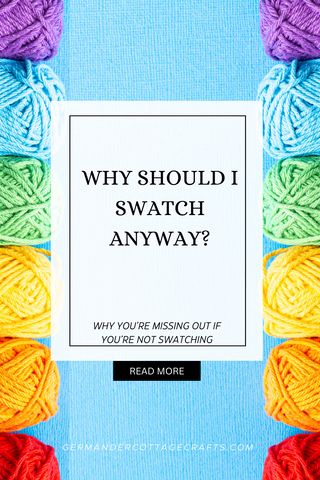Before you roll your eyes, just hear me out! Swatching isn't just about inconveniencing you. It could save you a lot of time, tears and money.
You may have come across several debates on swatching when it comes to knitting and crochet on social media. Some say only swatch for certain things, others say they've never had to swatch at all. Some people think swatching is only for knitting.

Make a swatch.
I was once like you. I was once a cavalier yarn enthusiast who understood very little about why a tension square even mattered. I just wanted to hurry up and make the damn thing. Sometimes I was lucky. Other times, I was not.
I spent a lot of money on lovely yarn only to then create something that did not fit. I didn't swatch. It's my fault.
If I could save every new crocheter or knitter from a big mistake like that, I would. If I only manage to save one of you, or if anyone even reads this advice, my endeavour was worth something.
Why should you swatch?
Here are the benefits:
- You can assess what your individual tension is. Is it tight, loose or just right? How will you know unless you swatch? Loose tension will make something too big and tight tension will make something too small!
- You can see how your chosen yarn behaves. Does it bloom or shrink when washed? Do you like how it looks?
- You can see how the different patterns will look, if the pattern uses more than one stitch repeat.
- Before you buy the fancy stuff, you can estimate how much yarn you'll need more accurately than just picking 2 or 3 extra balls.
- You can see that not all yarn is the same weight. Aran, for example, is not an equal thickness. The name is just about ply or general thickness. The actual thickness of yarns is not uniform.
Always make your swatch in the same conditions as you mean to make your item.
You cannot just assume that you will have the same tension as the designer or someone else who has used the same yarn as you.
When I was looking for a swatch for Keld Aran, I asked Victoria of Eden Cottage Yarns if she had already done one. She had! That swatch told me some interesting things.

It helped me to estimate how much yarn I would need for the design I had in mind.
For example, if 10 cm was getting 13 sts and 10 rows, I could estimate how much yarn would be needed to make something that was 60 rows long and 44 stitches wide. If you also weigh your swatch, you get even more helpful information for your estimate!
How to estimate yarn amounts from a swatch:
All you have to do is work out the total area, divide it by the size of your swatch and multiply it by the weight of your swatch. That gives you a rough estimate of how much yarn you'll need.
Example: A baby blanket that is 60cm (24in) by 60cm (24in).
The swatch is a 10cm/4in square, so it's an area of 100cm (16in) squared. It weighs 10g (0.3 oz)
- Multiply the panel(s) length and width: 60cm (24in) X 60cm (24in)= 3600cm (576in) squared.
- That's the total area for the 1 panel of the baby blanket.
- Divide the total area by the swatch area (100cm/16in)= 36
- Multiply this number by the swatch weight (10g/0.3oz)= 360g (13oz)
My estimate would suggest that to make a 60cm (24in) by 60cm (24in) panel, I would need 360g (13oz) for my blanket.
Just from one swatch, I get a yarn estimate. That's so handy for using scraps too! You can calculate what you might be able to use based on what you already have.
How do you do this with garments?
Add the total volume of the front, back and sleeves together before dividing it by the swatch and multiplying it by the weight of the swatch.
Should I swatch in the round?
If the pattern is for an item that is knit in the round, i would definitely say swatch in the round. The simple reason for this is that when you knit flat, you can have a very different tension purling than you do when knitting. You can also have quite loose edge stitches too.
Should I always swatch?
I wouldn't say that you have to swatch on absolutely everything. For example, a face cloth or a scrubbie won't necessarily need a swatch but common sense says definitely swatch for:
- Things that require yarn that you have a limited quantity of.
- Things that are expected to fit the wearer just as the pattern suggests.
- Things that you intend to make as a sample or sell. You may think it is a size 12 because the pattern says it was but if you didn't swatch, someone could be demanding a refund.
- Anything that could be severely altered by washing ie a garment. even sewists are encouraged to pre-wash their fabric because of the risk of shrinking.
If you're willing to go to sleeve island for months only to then end up with something that doesn't fit, ask yourself, could you have saved time, tears and money by just making a swatch?


